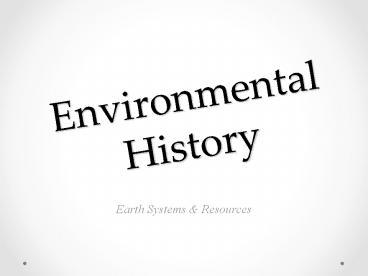Environmental History - PowerPoint PPT Presentation
Title:
Environmental History
Description:
Environmental History Earth Systems & Resources Essential Learning Questions / Objectives Define three major cultural and environmental changes that have occurred ... – PowerPoint PPT presentation
Number of Views:247
Avg rating:3.0/5.0
Title: Environmental History
1
Environmental History
- Earth Systems Resources
2
Essential Learning Questions / Objectives
- Define three major cultural and environmental
changes that have occurred since humans were
hunter-gatherers. - Describe the environmental history of the United
States in terms of the Tribal and Frontier Eras,
the Early Conservation Era, and the Environmental
Era. - Compare slash-and-burn agricultural practices
with the modern advanced forms of farming. State
the advantages and disadvantages of each. - List individuals who made major contributions to
conservation/environmental movements in the
United States and briefly describe these
contributions. - Define environmental backlash. Briefly describe
the effects of this backlash. - Summarize the key environmental events of the
1980s in the U.S. and the World - Compare and contrast the environmental policies
of the Clinton administration and the Bush
administration.
3
Early History
- Earth has existed for an estimated 4.6 billion
years - Homo sapiens have been on earth only about 60.000
years - Until about 12,000 years ago men were mostly
hunter-gatherers.
4
Cultural Changes the Environment
Hunter-Gatherers Humans (Homo sapiens) have been
in existence for about 160,000 years, a mere
blink of an eye in terms of biological life.
(early humans lived off the land
nomadic) Agricultural (Neolithic)
Revolution (10,000 to 12,000 years
ago) Industrial-Medical Revolution (began in the
1700s in England Progressed to United States in
the 1800s) Information and Globalization
Revolution (since 1950 and especially since 1970)
5
Hunter-Gatherers
- Survived by eating edible wild plants, fishing,
hunting, and scavenging meat killed by other
animals - Lived in small bands
- Were nomads
- They discovered
- Which plants and animals could be eaten and used
as medicine - Where to find water
- How plant availability changed throughout the
year - How game animals migrated
6
Advanced Hunters-Gatherers
- Used more advanced tools and fire
- Contributed to the extinction of some animals
(saber-toothed tiger) - Altered distribution of plants by carrying seeds
- OVERALL IMPACT ON THE ENVIRONMENT WAS LOW DUE TO
- Small population
- Low resource use/person
- Migration allowed ecosystem to repair itself
- Lack of technology
7
Agricultural Revolution
- 10,000-12,000 years ago
- Also called Neolithic revolution
- Gradual shift from nomads to settling in
agricultural communities - Domesticated animals and cultivated wild plants
8
Slash-and-Burn Cultivation
- Slash and Burn did destroy local environment, but
was usually very small and had a limited impact. - Still a problem
- in some parts
- of developing
- World. (Amazon)
9
Shifting cultivation
10
The Agricultural Revolution Trade offs
11
The Agricultural Revolution
- Most early farmers practiced SUSTAINABLE
CULTIVATION - Had little impact on the environment because
- Depended on human muscle power and crude tools
- Low population size and density
- Land was available for movement to other areas
12
The Industrial Revolution
13
The Industrial Revolution
- Began in England in the mid 1700s and in America
in the 1800s - Based on dependence on coal (nonrenewable fossil
fuel) rather than renewable wood - Invention of the steam engine
- Switched from small-scale localized production to
large-scale production of machine-made goods. - People began to live longer
- Movement from rural to cities
- Often very bad living and working conditions
14
Resulted in
- Fossil-fuel powered farm machinery
- New plant-breeding techniques increasing yield
per acre - More reliable food supply
- Longer life spans
- Increase in population size
15
Information Globalization Revolution
- Many new technologies telephone, computers, tv,
etc - Automated data bases
- Remote sensing satellites
- A shift took place where humans moved from
relying on wood and flowing water to a dependence
on machines run by nonrenewable fossil fuels
(first coal, then later oil and natural gas)































